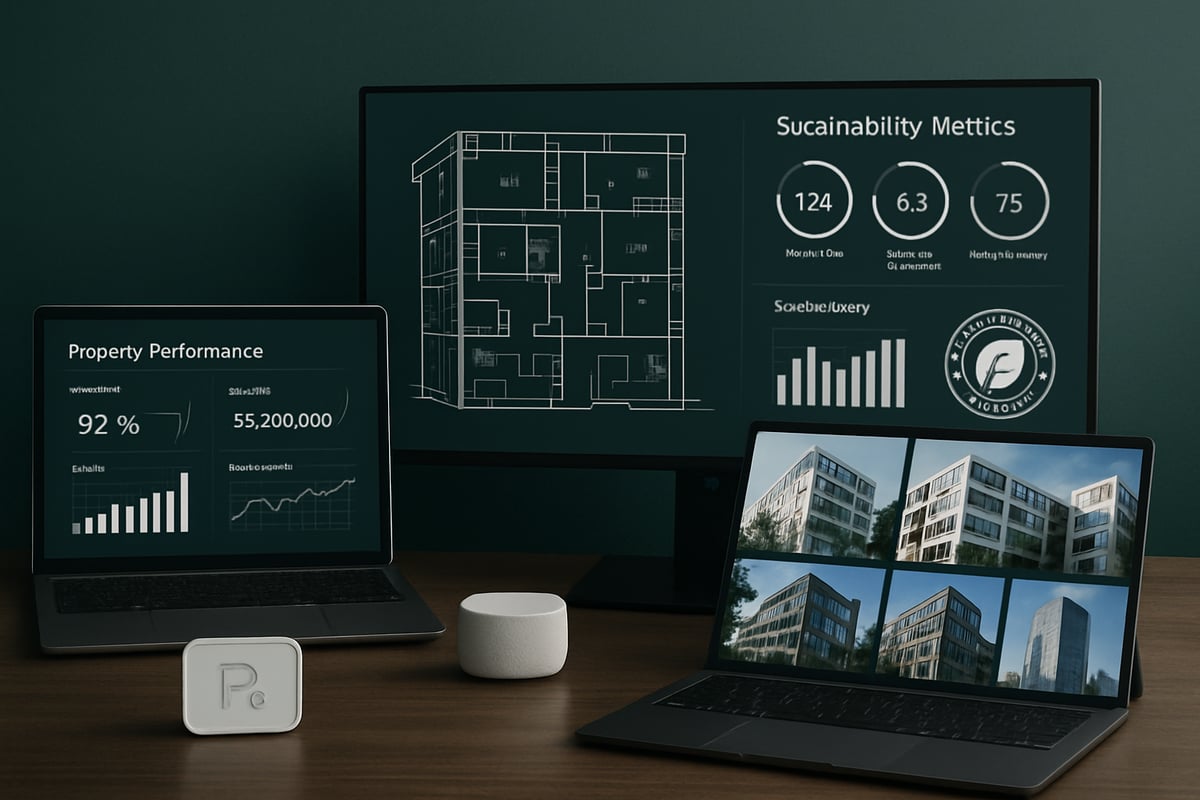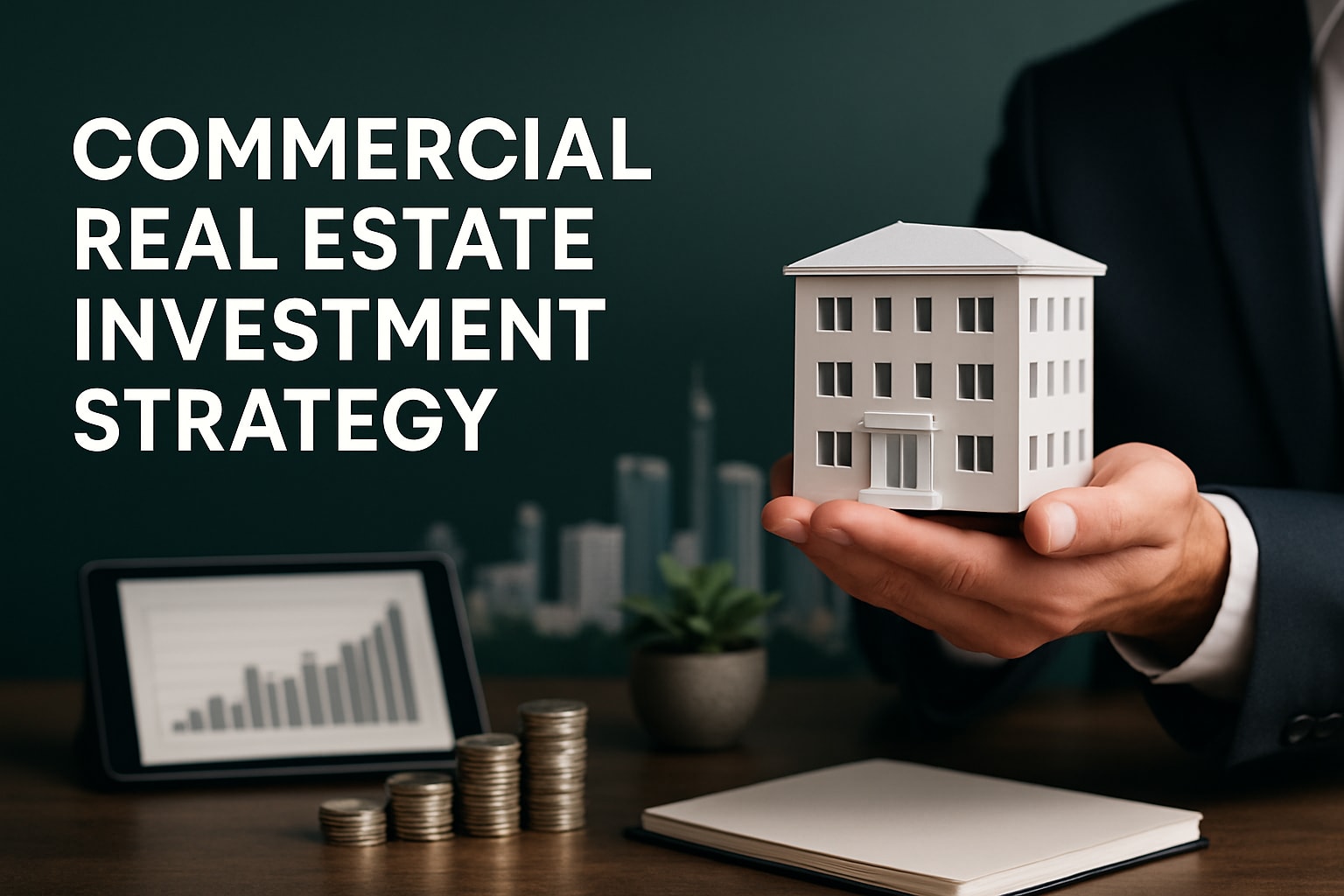As 2025 approaches, the commercial real estate investment strategy landscape is set for transformative change. Investors face new challenges and opportunities as market forces, technology, and regulations rapidly evolve.
This guide will help you build a resilient, data-driven approach that maximizes returns and reduces risk. You’ll find actionable frameworks, advanced tactics, and market insights designed for outperformance in commercial real estate.
Explore foundational strategy steps, master market and financial analysis, and uncover regional and sector trends. Dive into diversification, value-add opportunities, technology integration, sustainability, and emerging trends.
Ready to shape your success in 2025? Start planning strategically with this comprehensive guide.
Step 1: Defining Your 2025 Commercial Real Estate Investment Objectives
Setting clear objectives is the cornerstone of any successful commercial real estate investment strategy. By outlining your goals, risk tolerance, and financial road map, you’ll be better equipped to navigate the evolving CRE landscape in 2025.

Clarifying Investment Goals and Risk Tolerance
A robust commercial real estate investment strategy starts with aligning your investments to your long-term financial objectives. Are you focused on steady income, aggressive growth, or a hybrid approach? Each path carries different risk profiles. Assess whether you lean conservative or aggressive, especially as market conditions shift. For example, many investors pivoted after the pandemic, rebalancing toward less volatile assets. According to a 2024 survey, 80% of CRE investors found that having clear objectives was critical to outperformance. For more on strategic approaches, see this commercial property investment strategy guide.
Setting Time Horizons and Capital Allocation
Determining your time horizon is vital for any commercial real estate investment strategy. Are you investing for quick returns or long-term wealth creation? Consider your liquidity needs and how long you’re comfortable locking in capital. Diversifying across property types and locations can help manage risk, especially as economic cycles vary by region. For example, spreading investments between urban and suburban assets helped many investors ride out regional downturns. Avoid over-concentration in any single asset class to keep your portfolio flexible and resilient.
Regulatory, Tax, and Financing Considerations
Understanding the regulatory landscape is key to refining your commercial real estate investment strategy for 2025. Keep an eye on new rules that may affect property types or transaction structures. Tax impacts differ for direct ownership, REITs, or syndications, and smart financing decisions—like choosing between debt and equity—can boost returns. For instance, 2024 saw REITs deliver a 7% average yield, sometimes outpacing direct ownership. Interest rate fluctuations also shape leverage strategies, so stay updated on policy changes that could impact your bottom line.
Building a Strategic Investment Roadmap
Formalizing your commercial real estate investment strategy means creating a written investment policy statement. This document should include scenario planning for downturns, performance benchmarks, and regular review cycles. Many institutional investors use professional advisors to help establish and monitor these frameworks. Scenario planning—like stress-testing for market shifts—ensures you’re prepared for surprises. By setting clear benchmarks and review dates, you can stay agile and adjust your strategy as 2025 unfolds.
Step 2: Mastering Market and Financial Analysis for CRE in 2025
A solid commercial real estate investment strategy in 2025 hinges on mastering both market and financial analysis. With shifting market dynamics and rapidly evolving technology, investors who understand the numbers—and the stories behind them—will have a decisive edge. Let’s break down the frameworks and tools you’ll need to outperform in the modern CRE landscape.

Conducting Comprehensive Market Analysis
Understanding the market is the bedrock of any successful commercial real estate investment strategy. Start by analyzing supply and demand trends, rental growth, and vacancy rates. For instance, in 2024, office vacancies reached 16%, while industrial properties held steady at a low 4%. These numbers signal where opportunities and risks lie.
Dig deeper by evaluating economic drivers such as employment rates, demographic shifts, and planned infrastructure projects. Zoning laws and the development pipeline can dramatically affect future values. Take Detroit: strong local performance can be overshadowed by regional population decline, so context is key.
Incorporating third-party data sources and AI analytics helps you gain real-time market insights. For a step-by-step approach to market and financial analysis, visit Real estate investment analysis. This resource can help you sharpen your market read, a critical step in any commercial real estate investment strategy.
Financial Due Diligence and Forecasting
Once you’ve sized up the market, rigorous financial analysis becomes essential to your commercial real estate investment strategy. Focus on core metrics: Net Operating Income (NOI), Cap Rates, and Cash-on-Cash Return. Use historical data to project future income, expenses, and cash flows.
Sensitivity analysis is vital. Model best and worst-case scenarios—what happens to your returns if vacancy rates climb by 5%? In 2024, multifamily properties averaged 8-12% ROI, but these figures can quickly shift with changing market conditions.
Robust financial modeling isn’t just for institutions; it’s a non-negotiable step for all investors. By stress-testing your assumptions, you’ll identify potential pitfalls before they impact your commercial real estate investment strategy.
Technology Tools for Data-Driven Decisions
In 2025, technology is transforming how investors build a commercial real estate investment strategy. Leading CRE management platforms now offer real-time analytics, scenario modeling, and portfolio optimization at your fingertips.
AI-powered tools can flag emerging risks by analyzing vast datasets faster than any human. For example, some platforms automatically alert you to shifts in rental demand or regulatory changes that could impact asset performance. In 2024, 70% of top CRE firms adopted advanced analytics platforms, underscoring the industry’s shift toward data-driven decision-making.
Embracing these tools streamlines your due diligence and empowers smarter, faster investments—key advantages for your commercial real estate investment strategy.
Building Your Due Diligence Checklist
A comprehensive due diligence checklist is indispensable for any commercial real estate investment strategy. Start with property inspections, lease audits, and environmental assessments. Legal and compliance checks are especially important as 2025 regulatory updates come into play.
Here’s a quick due diligence checklist table:
| Due Diligence Step | Purpose |
|---|---|
| Property Inspection | Identify physical issues |
| Lease Audit | Verify income and obligations |
| Environmental Assessment | Uncover potential liabilities |
| Legal/Compliance Review | Ensure regulatory conformity |
Neglecting thorough due diligence can lead to costly surprises—think unforeseen capital expenditures or compliance issues. Remember, the upfront investment in a meticulous review is always less than the cost of a bad deal, safeguarding your commercial real estate investment strategy for the long term.
Step 3: Regional and Sectoral Insights—Where to Invest in 2025
Choosing the right region and sector is the backbone of any successful commercial real estate investment strategy. In 2025, market shifts and demographic patterns are more pronounced than ever, making location and asset class selection critical. Let’s break down how to target the best opportunities while managing risk and optimizing for growth.

Macro and Micro Location Analysis
Understanding where to invest starts with analyzing both national and local trends. Population shifts, such as the ongoing migration to the Sun Belt, are redefining demand for commercial space. Texas, Florida, and Arizona led the nation in net in-migration in 2024, fueling strong fundamentals for a commercial real estate investment strategy focused on growth markets.
Local infrastructure projects and economic drivers, like job growth and new transit lines, can create pockets of opportunity even in mature markets. Identifying emerging submarkets within larger metros often gives investors an edge. Diversifying across both established and up-and-coming regions helps hedge against local economic downturns and supports long-term stability.
Sector Performance Outlook for 2025
Each sector brings unique challenges and opportunities for a commercial real estate investment strategy. The office market continues to adapt to remote work, with adaptive reuse projects gaining traction. Industrial properties are thriving thanks to e-commerce and supply chain reshoring, with vacancy rates at a historic low of 4% in 2024. Retail is evolving toward experiential and mixed-use concepts, while multifamily assets remain strong, especially in suburban areas.
| Sector | Vacancy Rate (2024) | Key Trend |
|---|---|---|
| Office | 16% | Remote work, reuse |
| Industrial | 4% | E-commerce, reshoring |
| Retail | 8% | Mixed-use, experience |
| Multifamily | 6% | Suburban demand |
For a deeper dive into sector-specific performance, consult the 2025 Commercial Real Estate Outlook, which highlights the latest trends and investment opportunities.
Risk Factors and Downturn Scenarios
No commercial real estate investment strategy is complete without a clear-eyed look at risks. Regional economic dependencies, such as reliance on a single industry, can amplify vulnerabilities. Overbuilding in hot markets may lead to oversupply and declining rents. For example, Michigan’s population decline presents a long-term challenge for local CRE values.
Stress-testing your portfolio against regional shocks is essential. Scenario planning—considering events like a sudden drop in employment or unexpected regulatory changes—helps investors stay resilient. Balancing assets across different economic environments reduces exposure to localized downturns and supports consistent performance.
Diversification Across Regions and Sectors
Diversification is the cornerstone of a resilient commercial real estate investment strategy. Spreading investments across multiple geographies and property types reduces volatility and cushions against sector-specific risks. In 2024, diversified portfolios experienced 20% lower volatility than single-sector holdings.
A balanced approach might include blending office, industrial, and multifamily assets in growth markets while maintaining exposure to stable regions. This not only enhances risk-adjusted returns but also positions investors to capture upside from emerging trends. Regularly reviewing and rebalancing the portfolio ensures alignment with shifting market dynamics and personal investment goals.
Step 4: Advanced Strategies for Maximizing ROI
Unlocking maximum returns in 2025 means going beyond the basics. Investors need a commercial real estate investment strategy that leverages diversification, value-add plays, cutting-edge technology, and ESG principles. Let’s explore the most effective ways to build resilience and drive performance in your portfolio.

Diversification and Portfolio Construction
A robust commercial real estate investment strategy starts with smart diversification. Spreading investments across property types, regions, and tenant profiles reduces risk and smooths returns. History offers sharp lessons: over-concentration—like the Lehman Brothers’ collapse or the COVID-19 office downturn—can devastate unbalanced portfolios.
Consider blending residential and commercial assets to create stability. For example, a portfolio that mixes office, industrial, and multifamily assets can better weather market cycles. In 2024, diversified CRE portfolios outperformed single-sector portfolios by 1.5x, demonstrating the tangible benefits of this approach.
Key diversification tips:
- Allocate capital across multiple asset classes and regions
- Balance tenant types (corporate, retail, residential)
- Monitor regional economic cycles to adjust exposure
A disciplined commercial real estate investment strategy relies on periodic portfolio reviews and rebalancing to stay aligned with your risk tolerance and market trends.
Value-Add and Opportunistic Investments
Pursuing value-add and opportunistic deals is a core pillar of a high-performing commercial real estate investment strategy. These investments target underperforming or mismanaged properties with potential for repositioning and enhanced income.
Tactics include renovations, operational upgrades, and re-leasing strategies. Converting outdated offices into mixed-use or residential spaces is increasingly popular, especially in urban markets facing office vacancy challenges. Value-add projects delivered 12-16% IRR in 2024, outpacing many core investments.
Common value-add approaches:
- Renovate or retrofit aging properties
- Implement energy-saving upgrades
- Target distressed assets with upside potential
By thoughtfully integrating value-add opportunities, investors create a more dynamic commercial real estate investment strategy, capturing upside while managing risk.
Technology Integration and PropTech Innovations
Technology is revolutionizing every commercial real estate investment strategy. PropTech tools and IoT solutions now enable real-time analytics, predictive maintenance, and smarter asset management. In 2024, 60% of new CRE developments featured advanced PropTech integrations, and 70% of top firms used analytics platforms to optimize portfolios.
Smart building retrofits can reduce operating costs by 20%, while digital management platforms boost tenant engagement and streamline operations. AI-powered tools flag emerging market risks, helping investors act decisively.
Tech-driven advantages:
- Automated rent collection and expense tracking
- Real-time performance dashboards
- Predictive analytics for market and asset trends
Adopting these innovations ensures your commercial real estate investment strategy remains competitive and responsive to market shifts.
Sustainable and ESG-Focused Investing
Sustainability is now central to every commercial real estate investment strategy. Green buildings, energy efficiency, and wellness certifications are no longer optional—they drive tenant demand and command premium rents. In 2024, sustainable CRE assets achieved 7-10% higher rental premiums, while LEED-certified buildings saw higher occupancy rates.
ESG investment drivers:
- Tenant preference for eco-friendly, healthy workplaces
- Regulatory incentives and tax credits for green upgrades
- Enhanced asset value and reduced long-term operating costs
For actionable insights into sustainable building practices and emerging trends, see Top Strategies for Commercial Investments in 2025.
By integrating ESG principles, investors future-proof their commercial real estate investment strategy, aligning returns with long-term market and societal shifts.
Step 5: Financing, Partnerships, and Innovative Deal Structures
Securing the right financing and structuring deals creatively is pivotal for any commercial real estate investment strategy in 2025. Investors face a wider array of funding options and partnership models than ever before. Understanding these choices equips you to access opportunities, manage risk, and maximize returns in a shifting market.
Traditional vs. Non-Traditional Financing Options
The financing landscape for commercial real estate investment strategy is evolving rapidly. Traditional bank loans remain popular, offering stability, but often require significant capital and strict underwriting. In contrast, private debt, REITs, and crowdfunding platforms lower entry barriers and unlock new possibilities.
Here's a quick comparison:
| Option | Typical Investors | Minimum Investment | Liquidity |
|---|---|---|---|
| Bank Loans | Institutions, HNWIs | High | Low |
| REITs | Individuals, Funds | Low | High |
| Crowdfunding | Individuals | Very Low | Medium |
Crowdfunding, for example, enabled fractional ownership for 5% of CRE transactions in 2024, letting investors pool resources and diversify easily. For a deeper dive into these innovative structures, see this guide to fractional commercial property investment.
Joint Ventures, Syndications, and Private Equity
Choosing the right partnership model is crucial for a robust commercial real estate investment strategy. Joint ventures allow investors to combine capital and expertise, making larger projects feasible. Syndications, meanwhile, pool funds from multiple backers, often under a lead sponsor.
Private equity firms typically target value-add or opportunistic deals with higher return potential. Aligning incentives, clarifying roles, and structuring profit-sharing are essential in all these arrangements. Shared ownership can also mitigate risk and open doors to more ambitious investments.
Tax Strategies and Regulatory Compliance
Tax efficiency is a cornerstone of any commercial real estate investment strategy. For 2025, updates to depreciation schedules, 1031 exchanges, and local tax incentives will influence deal structures. Investors must stay vigilant about compliance, especially as regulations evolve.
Consider leveraging tax credits for sustainable upgrades or using tax-advantaged vehicles for ownership. In 2024, 30% of investors used such structures to boost after-tax returns. Partnering with tax professionals ensures your strategy remains both compliant and optimized for changing laws.
Scenario Planning for Interest Rate and Policy Changes
Interest rate volatility and policy shifts can dramatically impact your commercial real estate investment strategy. Modeling sensitivity to both fixed and floating rate debt helps you anticipate changes in cap rates and cash flow.
Hedging strategies, such as interest rate swaps or caps, offer protection if rates rise unexpectedly. For instance, 2024’s rate hikes required many investors to rebalance portfolios and renegotiate financing. Building flexibility into your capital stack—and regularly reviewing scenarios—keeps your strategy resilient in any policy environment.
Step 6: Building and Managing a High-Performance CRE Portfolio
Building and managing a high-performance CRE portfolio in 2025 requires more than just acquiring properties. Investors must embrace a holistic commercial real estate investment strategy that harnesses data, technology, and agile decision-making. Let's break down the essential steps to maximize returns and minimize risks in today’s evolving market.
Portfolio Monitoring and Performance Tracking
Active portfolio monitoring is the backbone of any commercial real estate investment strategy. Setting clear KPIs is crucial to track asset performance and spot opportunities or red flags early.
Key KPIs to monitor include:
- Occupancy rates
- Net Operating Income (NOI)
- Cash flow
- Internal Rate of Return (IRR)
Using real-time dashboards and analytics tools transforms raw data into actionable insights. For example, AI-powered platforms can automatically flag underperforming assets, prompting swift action. In 2024, portfolios with active monitoring achieved 15% higher returns than those with a passive approach.
Regular performance reviews help benchmark against market averages and your own investment goals. By integrating consistent portfolio tracking into your commercial real estate investment strategy, you create a feedback loop for continuous improvement and risk mitigation.
Asset Management Best Practices
Exceptional asset management is a hallmark of a resilient commercial real estate investment strategy. The day-to-day management of leases, rent collection, and tenant relations directly impacts your bottom line.
Best practices include:
- Streamlining lease management with digital tools
- Automating rent collection for multifamily and office assets
- Prioritizing tenant retention through personalized engagement
- Scheduling proactive maintenance and capital improvements
Automated rent collection, for example, has been shown to boost multifamily returns by reducing late payments and administrative overhead. Professional property managers can also add value, leveraging their expertise to optimize expenses and enhance tenant satisfaction.
For more guidance on operational excellence, you might explore Investing in commercial property, which offers practical tips for maximizing asset value. Embedding these best practices into your commercial real estate investment strategy ensures your portfolio is built for long-term success.
Risk Management and Contingency Planning
No commercial real estate investment strategy is complete without robust risk management. Economic shocks, tenant defaults, and market downturns can erode returns if not anticipated and planned for.
Effective risk management includes:
- Maintaining adequate insurance coverage
- Holding reserves for unexpected expenses
- Scenario planning for tenant defaults or prolonged vacancies
- Stress-testing your portfolio for market downturns
The COVID-19 pandemic highlighted the need for contingency planning, especially for office leases and retail assets. In 2024, CRE portfolios with robust risk plans experienced 30% fewer defaults compared to those without such safeguards.
By integrating these risk controls, investors can weather uncertainty and protect their capital, making their commercial real estate investment strategy truly resilient.
Scaling and Rebalancing Your Portfolio
Scaling and rebalancing are the final frontiers in building a high-performance commercial real estate investment strategy. Knowing when to acquire, dispose, or reposition assets is key to maintaining optimal portfolio health.
Key steps include:
- Regularly reviewing asset performance and market conditions
- Disposing of stabilized assets to fund value-add opportunities
- Rebalancing in response to economic cycles or shifting personal goals
For deeper insights on portfolio rebalancing and market acceleration, check out 10 Insights for CRE Investors in 2025, which highlights strategies to stay ahead in dynamic markets.
Periodic portfolio reviews ensure alignment with your commercial real estate investment strategy. This disciplined approach enables investors to capture upside potential, minimize downside risk, and adapt as the market evolves.
Step 7: Future Trends and Emerging Opportunities in CRE for 2025
As the commercial real estate investment strategy landscape evolves in 2025, investors face both transformative opportunities and emerging risks. Staying ahead means understanding the technology, demographic, global, and regulatory forces shaping tomorrow’s CRE market.
AI, Automation, and Data-Driven Investing
Artificial intelligence is rapidly transforming commercial real estate investment strategy. AI-driven platforms now analyze site selection, automate underwriting, and forecast market risks with remarkable accuracy. Automation streamlines asset management, from leasing to maintenance, freeing up time for strategic decisions.
For example, platforms leveraging AI can flag market inflections before traditional data sources catch up. In 2025, 80% of CRE investors plan to expand tech adoption, making digital tools central to any forward-looking commercial real estate investment strategy. For a deeper dive into anticipated industry themes, see Turning the Corner? Commercial Real Estate Themes for 2025.
Demographic and Societal Shifts
Demographic changes are rewriting the rules for commercial real estate investment strategy. The rise of remote work has shifted demand toward flexible office space and logistics hubs. An aging population drives demand for healthcare properties, while urbanization and wellness trends push multifamily and mixed-use developments.
For instance, suburban multifamily demand surged 12% year-over-year in 2024, reflecting shifting tenant preferences. Investors must adapt their commercial real estate investment strategy to anticipate these evolving needs and capture new growth segments.
Globalization and Cross-Border Investment
Expanding a commercial real estate investment strategy internationally brings both diversification and complexity. Global capital is increasingly flowing into U.S. and Australian CRE markets, seeking stable returns and geographic diversification.
However, cross-border deals introduce currency risk and regulatory hurdles. In 2024, cross-border CRE transactions climbed 18%, highlighting the appeal of global exposure. Investors crafting a commercial real estate investment strategy should weigh these opportunities against potential challenges for optimal portfolio balance.
Regulatory, Environmental, and Policy Drivers
Policy shifts will have a profound impact on commercial real estate investment strategy in 2025. New zoning laws, tax reforms, and green building mandates are reshaping asset values and investment decisions.
For example, updated energy standards are driving retrofits and boosting demand for sustainable assets. Commercial real estate investment strategy must remain agile, allowing investors to respond quickly to regulatory changes while capitalizing on incentives for ESG-focused properties. Staying proactive ensures portfolios remain resilient and future-proof.
You’ve just explored the key strategies, market insights, and advanced tactics to help you make confident commercial real estate decisions in 2025. But building a resilient, high-performing portfolio—especially with your superannuation—can feel overwhelming without expert guidance. That’s where we come in. If you’re ready to take action, align your investments with your retirement goals, and make the most of every opportunity the coming year offers, let’s have a conversation about your next steps.
Start Building Your Wealth—Speak With an Expert




